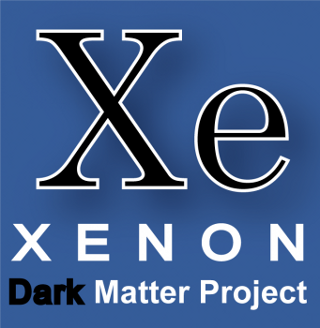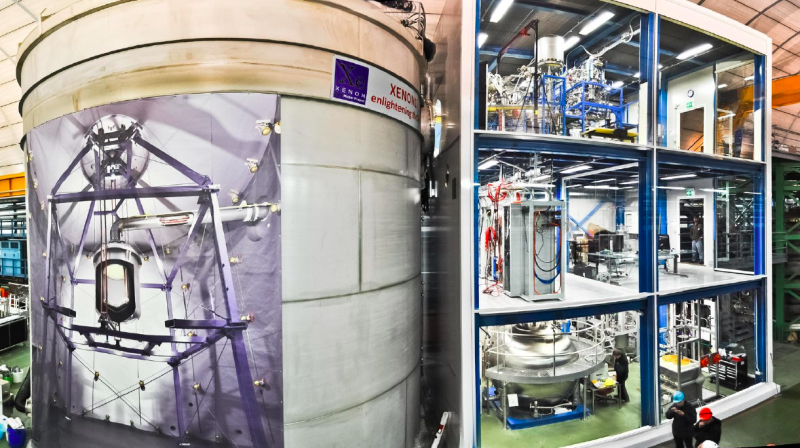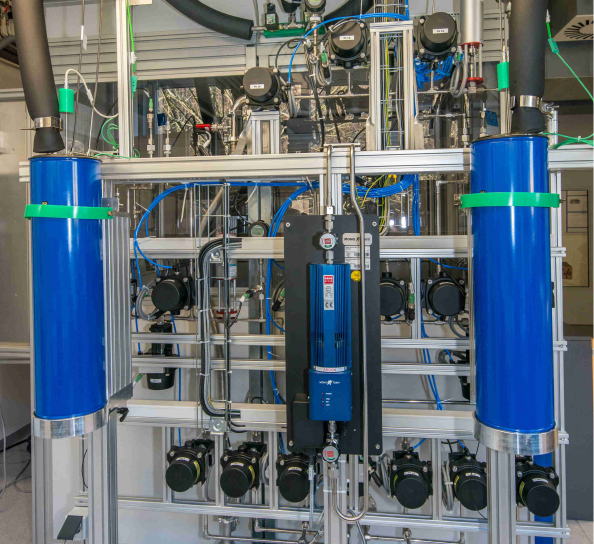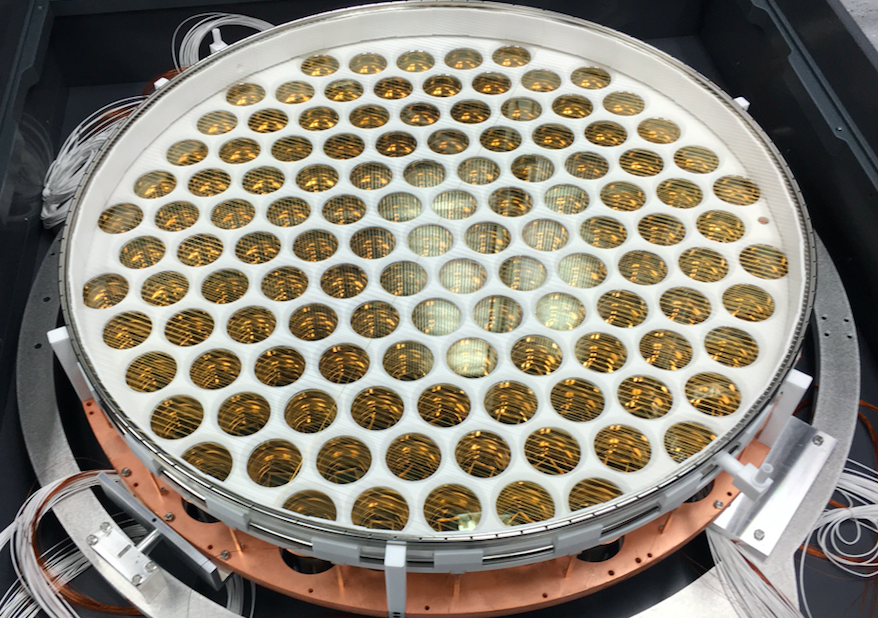
Research: XENON
The Search for Dark Matter with Liquid Noble Gas
Indirect Evidence for Dark Matter
Everything we observe on Earth is composed of ordinary, so-called baryonic, matter. However, various astrophysical and cosmological observations strongly suggest that there exists another kind of matter in the Universe. It is not composed of any kind of particles that we know and does not emit any radiation. As a consequence, it cannot be observed directly and is thus named dark matter. Nevertheless, dark matter particles have a non-zero mass and form large structures in the Universe that interact gravitationally with stars and galaxies. We can observe these gravitational effects in the dynamics of galaxies and galaxy clusters, as well as in gravitational lensing measurements. An analysis of the cosmic microwave background suggests that there is about five times more dark matter than ordinary matter.
In spite of this huge amount of dark matter, we still don't know what it is made of. One of the most popular theories suggests that dark matter consists of Weakly Interacting Massive Particles (WIMPs), which would have masses comparable to atomic nuclei, therefore forming cold dark matter. Such particles could, in principle, have occasional feeble interactions with ordinary matter. Since dark matter is believed to exist everywhere throughout our galaxy and constantly pass through the Earth, we aim to observe such interactions in detectors specifically designed to identify the nature of dark matter.
The Search for Dark Matter with Liquid Xenon

Figure 1: The XENON1T detector at the LNGS underground laboratory.
The XENON Collaboration works on the direct detection of dark matter particles using a dual-phase liquid Xenon (LXe) detector.
Currently, the XENON1T detector is running at the Gran Sasso National Laboratory (LNGS) in Italy (see figure 1). It is the successor of the XENON10 prototype and the XENON100 detector.
With a fiducial mass of about 2 tons, it has provided some of the best limits for the WIMP-nucleus cross section.
The XENON1T detector is a time projection chamber (TPC). The detection mechanism is based on the idea that a dark matter particle interacting with a xenon nucleus in the liquid phase produces a charge signal from ionization and light signal from scintillation. Photomultiplier tubes (PMTs) are used for the detection of both signals. While the light signal, usually named primary scintillation signal (S1), can be measured directly, the charge signal has to be converted into a secondary light signal (S2). This is achieved by an electric field which separates the ionization electrons from the interaction vertex and extracts them into the gas phase, where proportional scintillation takes place. The delay between the S1 and S2 signals corresponds to the electron drift time. This way, the z-component of the interaction vertex can be precisely reconstructed. Using the photon hit pattern in the top PMT-array, also the x-y coordinates can be measured resulting in 3D-positioning of the event with millimeter precision.
XENON at MPIK

Figure 2: Setup for the automatized measurement of radon emanation (AutoEmma).
Owing to the very small interaction rates that are expected for dark matter, it is essential for any direct detection experiment to have a very low background. For this purpose, the experiment must be placed deep underground. The Gran Sasso Underground Laboratory, where the XENON1T experiment is located, for example, provides a shielding of 3800 meters water equivalent of rock.
In addition a water tank in which the detector is situated is used as an active veto against remaining cosmic radiation.
Furthermore, only the innermost part of the target mass is used for analysis in order to make use of the self-shielding properties of LXe, reducing the total background. Finally, the ratio of S1/S2 allows for a discrimination between electron recoils (background) and nuclear recoils (signal).

Figure 3: Mass spectrometer for measuring the krypton content of xenon.
An experiment like XENON requires a high purity of all materials used in the construction of the detector. First of all, the materials used in the detector must be carefully selected for low intrinsic radioactivity. High purity germanium detectors operated at LNGS (so-called GeMPIs) and at the MPIK shallow lab are used to select the most radio-clean materials.
A low radon emanation rate is an additional quality of all components of the detector.
The MPIK developed a setup that determines the radon emanated from various material and detector components in an automized and highly reproducible way (see figure 2).
Alongside this, methods to further suppress the radon induced background are investigated at the institute.
Besides radon another background source of the experiment is due to the noble gas krypton.
Krypton is present in commercial xenon gas at the ppm (parts per million) level.
Continous distillation allows to lower the krypton fraction within the detector below the ppt (parts per trillion) level.
A system to determine krypton traces above a detection limit of few ppq (parts per quadrillion) has been developed and samples from the XENON1T detector with less than 1 ppt sensitivity have been measured (see figure 3).

Figure 4: Photomultiplier array of the XENON1T detector.
To ensure the functionality of the photomultipliers used in the detector, a large fraction of them have been measured and tested at the institute (see figure 4).
An important background of the XENON1T detector is due to the decay of radioactive impurities located on the walls of the detector.
For the XENONnT detector, which will be the upgrade of the XENON1T experiment, it is necessary to reduce this background.
To achieve this goal different surface treatment methods are investigated at the institute.
To evaluate possible effects of these cleaning methods on the chemical purity of the liquid xenon, a 5 cm long liquid xenon time projection chamber has been set up at the MPIK.
Besides investigations concerning purity of xenon, the fundamental scintillation properties of xenon will be studied with this detector.
Further more the division contributes to the data taking and data analysis of the XENON collaboration and performs maintance tasks for the detector.
Future Perspective
The ultimate aim of the XENON collaboration is to further scale up the detector to gain significantly in sensitivity.
The next stage is going to be XENONnT, which is currently under construction at LNGS. It aims for another factor of 10 improvement in sensitivity compared to XENON1T. To achieve this goal, all possible sources for background must be further reduced such that the total background is about a factor of 10 below the one of XENON1T.
The XENONnT detector is supposed to take data until 2023, before it will be replaced by the DARWIN experiment which is currently beeing planned.
The XENON Collaboration
The XENON Collaboration consists of
- Columbia University, New York, USA
- INFN and University of Bologna, Italy
- INFN, Gran Sasso National Laboratory, L'Aquila, Italy
- INFN Torino, Italy
- Johannes Gutenberg University, Mainz, Germany
- Istituto Nazionale di Fisica Nucleare Napoli, Italy
- Kavli IPMU, University of Tokyo, Japan
- Kobe University, Japan
- Laboratoire de l’Accélérateur Linéaire, France
- Laboratoire de Physique Nucléaire et de Hautes Energies, France
- Max Planck Institute for Nuclear Physics (MPIK), Heidelberg, Germany
- National Institute for Subatomic Physics (NIKHEF), Amsterdam, The Netherlands
- NYU Abu Dhabi University, United Arab Emirates
- Nagoya University, Japan
- Purdue University, West Lafayette, USA
- Rensselaer Polytechnic Institute, Troy, USA
- Rice University, Houston, USA
- Stockholm University, Sweden
- SubaTech, Nantes, France
- University of California, Los Angeles, USA
- University of California, San Diego, USA
- University of Coimbra, Portugal
- University of Freiburg, Germany
- University of Münster, Germany
- University of Zürich, Switzerland
- Weizmann Institute of Science, Rehovot, Israel
Links
More information and current news including publications and the status of XENON1T can be found on the
official homepage of the XENON collaboration.
Contact
- Prof. Dr. Manfred Lindner:
Tel: +49 6221 516800
E-Mail: manfred.lindner [at] mpi-hd.mpg.de
- Priv.-Doz. Dr. Teresa Marrodán Undagoitia:
Tel: +49 6221 516803
E-Mail: teresa.marrodan [at] mpi-hd.mpg.de
- Dr. Hardy Simgen:
Tel: +49 6221 516530
E-Mail: hardy.simgen [at] mpi-hd.mpg.de